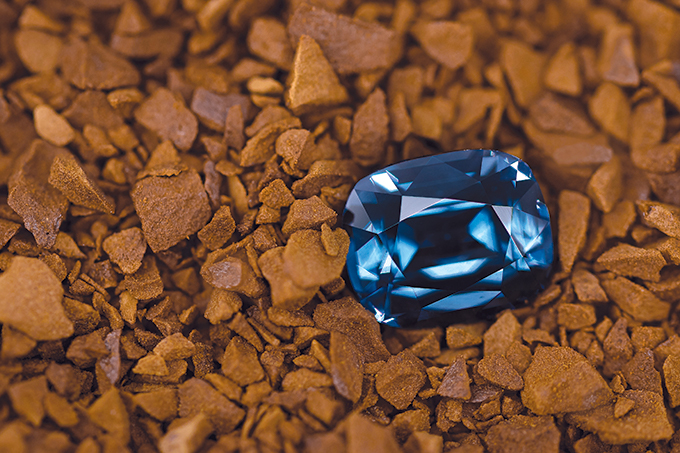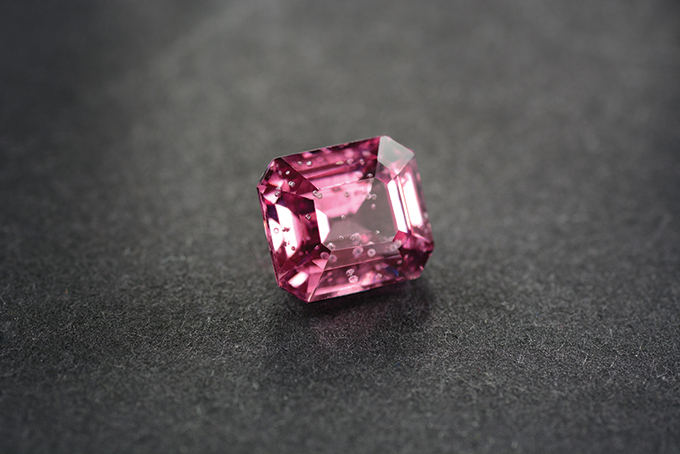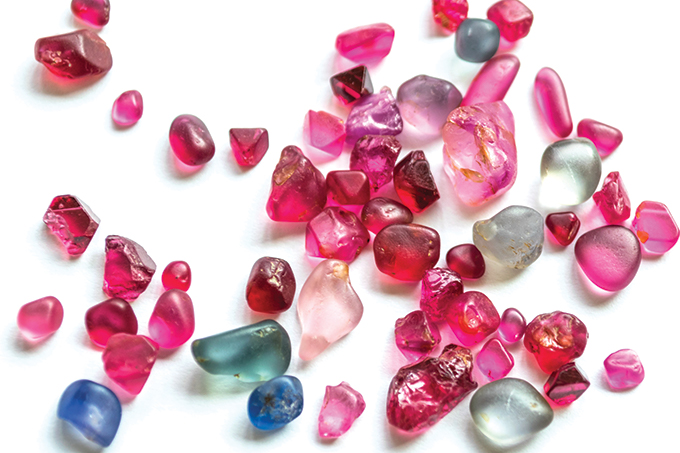The multifaceted spinel continues to fascinate seasoned buyers while finding favour among a younger clientele that values its universal allure and versatility.
This article first appeared in the GEMSWORLD 2024.
Market interest in spinel has consistently followed an upward trajectory, bolstered in part by rising demand for ruby alternatives but more so by buyers becoming more educated and adventurous in their coloured gemstone choices.
According to gem dealers, spinel’s vivid red colour and compelling history are major selling points, high prices notwithstanding. Other colours are gaining popularity too, alongside spinel from sources other than renowned mines in Tanzania and Myanmar (formerly Burma).
Viewed as an extremely versatile gemstone, spinel has a global audience, spanning top destinations like the US, Europe and Asia. Interestingly, younger people are also taking notice of spinel, enticed by the gem’s inherent individuality and wide range of hues.
Era of reds and pinks
Spinel is gradually but steadily gaining traction in the coloured gemstone universe. Mehreen Yousaf, business development manager at Spinel House, said the gem is increasingly being considered by many as investment pieces.
“Some would acquire spinel and keep it over the next five years before reselling at a higher price,” she explained. The company, which mainly deals in Burmese spinel, has a solid customer base in Hong Kong, Thailand and India.
Buyers mostly go for intense red and glowing hot pink spinel – or those bearing the so-called “jedi” colour, she said. They are also particular with the size and shape of the stone. Those looking for a single stone would purchase gems of three carats to 10 carats while some jewellers would opt for spinel stones of over 10 carats.
Smaller stones are similarly moving fast. Sasha Golokoz of Vitalit said petite gems from the famed Mahenge mine in Tanzania bearing a stunning pinkish-red colour are most ideal for dainty, ultra-feminine jewellery pieces.
“Unfortunately, we currently do not have these colours in big sizes, but the small-sized gems work best in earrings,” shared Golokoz.
Baby pink spinel from Vietnam is likewise a crowd favourite, joining the ranks of reddish-pink or pinkish-red spinel stones that are enjoying strong market interest. Golokoz added, “People are drawn to pink because jewellery is primarily for women. These bright and attractive colours are especially attractive to the younger generation. Meanwhile, red is always king in the spinel world.”
Mohamed Azharudeen Salahudeen of Star Lanka Co Ltd agreed, adding that buyers mainly ask for neon red or pink spinel. He described the post-Covid market as increasingly “colour conscious.”
Consumer education plays a significant role in the changing landscape of the gemstone business as buyers have become more specific and sophisticated in their requirements, added Salahudeen. Premium neons hail mainly from the Mahenge mine, which is known to produce the most coveted red and pink spinel stones.
Gems of value
According to Salahudeen, a high-quality spinel from Mahenge could sell for anywhere between US$20,000 and US$100,000 a carat, depending on the clarity and colour of the gem.
Golokoz of Vitalit explained that prices, while consistently on the rise, remain acceptable to buyers who are truly knowledgeable about the stone’s value.
“Our prices are not cheap, but our customers are willing to pay a premium. They understand that it is a rare material,” she continued. “On average, per carat prices are about US$2,000 for a 1-carat to 2-carat stone. Bigger gems could go for about US$10,000 a carat.”
Gaetano Savella, director at Claudia Hamann Edelstein GmbH, maintained that spinel prices are still affordable and would vary considering gem quality and colour intensity. For instance, a top-quality Burmese red spinel could have a price tag of about US$2,000 to US$2,500 per carat.
While reds or pinks are highly favoured in the market, interest in other colours is also mounting. According to the Gemological Institute of America, spinel comes in a range of fascinating hues – from orange to intense “stoplight” red, vibrant pink, and all shades of purple, blue and violet to bluish green.
“Cobalt blue and grey spinel have a solid following, too. I would say all spinel colours are in the limelight now,” noted Savella. “In terms of shapes and sizes, cushions and ovals are the most sought after in the trade.”
An interesting development is the rising number of mainland Chinese customers asking for spinel. Savella remarked, “I used to sell spinel in the US and Europe. But now, China is also taking notice. This is quite interesting.”
Salahudeen has the same observation, adding that Chinese buyers are actively seeking out spinel at international trade fairs. “They have become more educated about coloured gems. It is an evolving market. Their understanding of gems today compared to 10 years ago is astounding. They trade armed with the knowledge of what makes a stone special – the cut, colour and clarity. And they are ready to pay a premium for quality goods,” he said.
Sparkling future
Yousaf of Spinel House said the market’s growing penchant for rare gems will bolster demand for spinel amid continued price increases. She expects more markets such as the US to gradually discover spinel and its extensive range of colours.
“What makes spinel special is that it is fundamentally beautiful,” she remarked. “It is clean, with a good lustre, and it is a natural stone that does not need treatment.”
Spinel’s most attractive trait, apart from its colour, is its versatility, noted Golokoz of Vitalit. This is also the reason why a younger generation of buyers are captivated by the stone. Vitalit’s major markets are Taiwan, Hong Kong, China and Europe.
“We sell to some private jewellers who work directly with the final customer who, I understand, are younger people. They go to special occasions too, of course, but I think they wear spinel because it is more relaxed and fun. Pink, for instance, is such a happy colour,” said Golokoz.
Exceptional colours – like those exhibited by spinel – will always be attractive in an increasingly discerning gemstone market, she added.
Salahudeen of Star Lanka said spinel has become a strong contender in the coloured gemstone business as demand further strengthens and prices escalate.
A more promising coloured gemstone market also bodes well for spinel and other non-traditional gemstones. The sector is on the cusp of an important milestone, supported by consumer education and the rise of social media platforms as informative tools.
More and more people are also expected to gravitate towards coloured gemstones when scouting for investment pieces, noted Salahudeen. “The gemstone sector is poised for further growth, thanks to continued education, evolving consumption trends and increasing appreciation for high-end, premium-quality gems,” he said.
FACTS
Mineral: spinel
Chemistry: MgAI2O4
Colour: red, orange, pink, purple, blue, black
Refractive index: 1.718
Birefringence: none
Specific gravity: 3.60
Mohs Hardness: 8
Source: Gemological Institute of America













